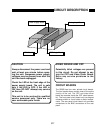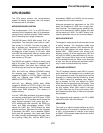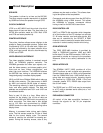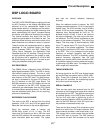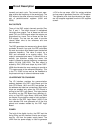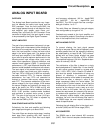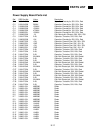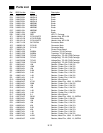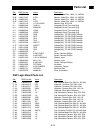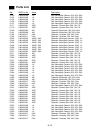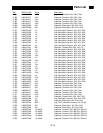
9-8
Circuit Description
transmit port each cycle. The transmit port oper-
ates at twice the frequency of the receive port. The
DSP writes to the other channel of each DAC via a
pair of parallel-to-serial registers (U504 and
U505).
DAC OUTPUTS
Three of the DAC output channels provide Sine
Out, X and Y. The fourth channel is multiplexed
into eight slow outputs. Two of these are the front
panel CH1 and CH2 outputs when the outputs are
proportional to a trace. Four of these are the Aux
D/A outputs. The last two are used to provide
internal offset trims to the reference and sine
discriminators.
The DSP generates sine waves using direct digital
synthesis. At each 4 µs cycle, the DSP calculates
the next sine output value based upon the desired
reference frequency. This value is output via a
DAC and converted to an analog output. This
output is a sampled sine wave. To convert this to a
smooth, low distortion analog sine wave, the
output is filtered to remove frequency components
above 100 kHz (U201-203). The filter output is
scaled by DAC U206 and output by driver U207.
U209 discriminates the zero crossings to provide a
TTL square wave at the reference frequency. This
is the TTL SYNC out as well as the feedback to
the phase lock loop in external reference mode.
I/O INTERFACE TO CPU BOARD
The I/O interface provides the communication
pathway between the DSP Logic Board and the
main CPU Board. U610 and U613 are buffers for
the address and data bus connections. Both buffer
chips are enabled only when the CPU Board is
writing to the DSP Logic Board. This helps isolate
the activity on the CPU Board from affecting cir-
cuitry on the DSP Logic Board. U608 and U609
are simple D-type latches used to hold configura-
tion data for the DSP Logic Board. U606 is the
main decoder PAL and generates all of the chip
selects and strobes needed by the DSP Logic
Board.
POWER
The bulk of the digital circuitry, the DSP and the
timing PALs and the interface circuits are all pow-
ered by +5V from the power supply board. The
±22V from the power supply is used to generate
±15V for the op amps. ±5.6V for analog switches
and op amps is generated from the ±15V supplies.
The reference and sine discriminators use separ-
ate ±5V supplies regulated from the ±15V supplies
as well.




